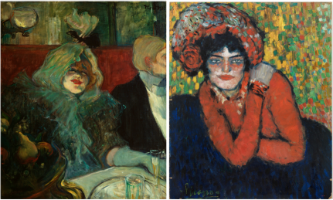
MADRID – The Paseo Museo Thyssen-Bornemisza will present a major exhibition by modern masters Henri de Toulouse-Lautrec and Pablo Picasso this fall.
Lautrec (1864‒1901) and Picasso (1881‒1973) never met. By the time Picasso visited Paris for the first time in October 1900 when still a boy, Lautrec was seriously ill and died the following year. Even so, Lautrec’s radical oeuvre and his conception of modernity made a powerful impact on the young Picasso.
Through him, Picasso discovered the many facets of modern society that influenced his approach to art. Although these affinities are well known, “Picasso / Lautrec,” is the first monographic exhibition to carry out a comparative study of these two great masters of modern painting.
Through more than 100 works grouped around the themes that interested both artists – caricature portraits; nightlife in cafés, cabarets and theaters; the harsh reality of marginal individuals; the spectacle of the circus; and the erotic universe of brothels – it shows that Picasso’s dialogue with Lautrec, with influences and coincidences, is not limited to the Spanish painter’s early work but spans his entire output up until his mature period.
Lautrec’s artistic career lasted barely 15 years, whereas Picasso’s spanned more than seven decades. Both were brilliant artists from childhood; both were attracted by Paris during their youth; and both rejected the academic teachings imposed on them. But above all, their mastery of drawing was one of the key factors that gave meaning to both artists’ oeuvre.
Both Lautrec and Picasso drew compulsively throughout their lives, had a special fondness for line and caricature, and filled hundreds of notebooks with extraordinarily skilled drawings from a very early age. It can be said that both men thought and expressed themselves in drawing and that any new work was preceded by endless testing and experimentation on paper.
But perhaps their main affinity lies in their approach to painting. The changes Lautrec made to the subjects of his works were not simply a question of description but also one of perception: distorted, unnatural perspectives, figures cropped by the frame, and motifs captured from behind figures stem from an intention to bring the spectator into the scene. Picasso went one step further by subjecting pictorial forms to a process of reduction, destruction or metamorphosis that can already be glimpsed in some of Lautrec’s images.
Organized by the Museo Thyssen-Bornemisza, the exhibition will run at the Madrid museum from Oct. 17 through Jan. 21, 2018.



